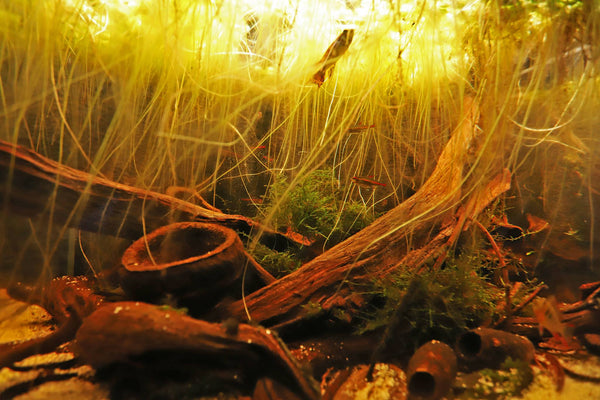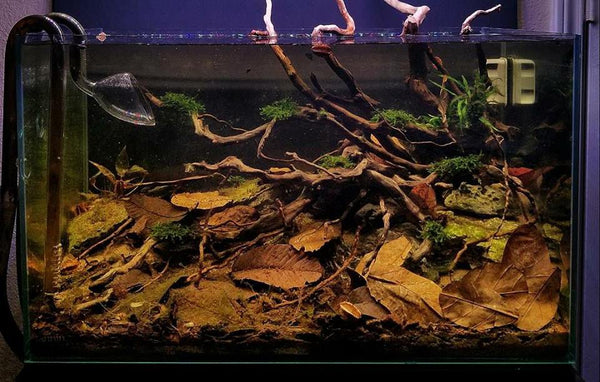- Continue Shopping
- Your Cart is Empty
The biggest question....The biggest impact...
It's pretty obvious that we are collectively gaining more and more experience in selecting, preparing, and utilizing botanicals in our aquariums. And the neat thing is that we have evolved in terms of what works for our new systems and how to integrate them into existing aquariums.

That being said, there are still lots of questions from those new to the botanical fray, which are important and foundational to our "botanical practice!" Apart from, "Hey, Scott, what are your favorite botanicals?", the question we receive the most here at Tannin Aquatics is, "How many do I need for my ___ gallon aquarium?"
And you'll just love my well-thought-out and concise answer:
I don't know.
No, seriously! Not being "evasive" or "noncommittal" here, either!
Apart from a few safety concerns about too much/too fast/too soon, there are few real "absolutes" when it comes to this stuff.
The reality is, it depends on a lot of factors, ranging from the size of your aquarium, to the habitat you are trying to replicate, or the concept your are trying to execute. And of course, there is your personal aesthetic. Let's examine some of the main factors that will influence your decision about "how many botanicals" to add to your aquarium.

Honestly, there is no "secret formula" that we've developed to tell you exactly how many of which botanical will produce a given amount of "tint" in the water. No "botanical calculator" like there is for how much sand to use in a reef tank...that sort of thing. It's virtually impossible to do this, because the degree to which the botanicals influence your water chemistry, overall aesthetics, and the color of the water itself are influenced by a myriad of factors, including the pH, amount of flow, what types (and how much) of chemical filtration media you employ (if any), the size of the aquarium, where you place the botanicals (i.e.; in a filter or reactor, or just on the substrate), etc.
This is part of the reason that I just despise the asinine "recommendations" you see on those vendor sites about how many Catappa leaves or whatever to add to your tank. No one knows this. Not some guy in Malaysia. Not the "expert" aquarist on YouTube. Not this guy who worships botanicals. No one! Period. End of discussion. There is no "universal formula" out there to determine how many to add. It's purely arbitrary.
And I will be the first to admit that I think we totally fell into that trap just a bit when starting Tannin: "Use X number of Catappa leaves for every X gallons of water..." Urrghh! I think it was because we wanted to give a sort of starting point for testing them...and perhaps set how many of each item would be in a pack, which I suppose is responsible to a certain extent. Yet, with all of the potential variables... yeah. I really HATE these types of recommendations. I am regularly revising our product descriptions to nix those awful advisories, as they are not only unprofessional- theyre inaccurate, ridiculously subjective, and simply impossible to generalize.
Yes, I'm mad at myself about it!
SO, how do you decide how many to use? It really boils down to a few things (in no particular order):
What is your "base" water chemistry, and how much are you trying to influence it by using botanicals? We've written ad nauseam about the fact that botanicals will have extremely limited impact on the pH of your water if it has high carbonate hardness, and will have no impact whatsoever on the carbonate hardness itself. They may increase TDS as they decompose, but the impact on the "big two" factors above is generally quite limited!
If, however, you are starting with water that has little to no carbonate hardness (ie; RO/DI), the impact of botanicals may be significant and you'll need to experiment and measure. You might, indeed, develop some crude "Use X number of catappa leaves per gallon to lower the pH by approximately____" formulas for yourself over time, although there will be no super-lab-grade accuracy and precise ability to replicate results every time..

What type of "look" are you trying to achieve? It goes without saying that if you are trying to replicate an Orinoco Basin "blackwater" tributary, with it's accompanying lower pH and tint, then you'd probably want to either go heavier on the botanicals (i.e., volume of botanicals to water volume), or employ botanicals which have shown to inflect water coloration and chemistry more significantly. For example, you'd be advised to use greater quantities of Catappa leaves, Catappa bark, Coco Curls, "Fundo Tropical", "Ceu Fruta ", Alder Cones, "Rio Fruta", Banana Stem pieces, etc.

Do you want the botanicals to be the main aesthetic feature, or just a compliment? We've seen quite a few aquariums where the goal was to utilize the botanicals (particularly the larger, more "permanent" ones, such as "Jungle Pods", "Savu Pods", "Tapete Pods", "Ra Cama", etc.) as the major part of the "hardscape." Obviously, the ratio of botanical material to water volume has a real impact on the aquatic environment, and should be a significant consideration when you're using a lot of stuff in your scape.

At this point in the discussion, I should point out that it is absolutely possible to utilize aquatic botanicals in your aquarium- even in significant numbers- and not let them tint the water significantly, or at all. By utilizing chemical filtration media, such as activated carbon, Purigen, Poly Filter, or a combination of them, you can enjoy the aesthetics of aquatic botanicals without any tint.

I know this for a fact, of course, because I've done this myself as part of testing, and because we've featured some of the beautiful aquariums from Aquarium Design Group and by the talented Andrea Freel, which employed significant amounts of botanicals, are typically devoid of tint by using the aforementioned filter media.

Are you adding botanicals to an existing aquarium, or starting from scratch? This is an important consideration, because when you are adding botanicals to an existing aquarium, you must consider the impact on the water chemistry, bioload, and "maturity level" of your aquarium (ie; its capacity to process nutrient inputs). As we have stated numerous times here in "The Tint", adding a large number of botanicals all at once to an established, stable aquarium (or even a new, not-fully-established, but populated one) can have very negative impact on the inhabitants.
This is not some new and unique concept just applicable to what we do here. If you add a large enough quantity of just about ANYTHING to an established aquarium, there will be an impact on the water quality. It may sound a bit harsh, but pretty much every single one of the very, very few "wipeout scenarios" we've seen in the three years we've been in business experienced by aquarists utilizing botanicals could be attributed to a rapid, large influx of botanicals being added to an established, stable aquarium.
What ensued in these instances was a rapid depletion of oxygen and an increase in CO2 as a result of a huge increase in bioload way, way faster than the biological filtration capacity of the aquarium could absorb. The result was fishes gasping at the surface, many essentially dying quickly. This stuff is serious. Although it's fun to add botanicals to your 'scape, and get the tank looking awesome quickly, the reality is that you need to proceed slowly and observe the impact on your fishes all along the way.

Another caveat? There is no substitute for proper preparation of your botanicals before using them in your aquarium. This is a vital step in the process, and can help avoid many potential problems. The boiling or steeping process helps soften the botanicals in order to help them saturate and sink, as well as to release any pollutants (dirt, etc.) from the surface tissues of the botanicals. Remember, we're talking about adding dried plant materials of terrestrial origin to water!
They are going to react. They will release substances that will influence water chemistry and coloration, but you can control the degree to which they do so through some of the aforementioned methods. Also, longer "post boil soak" periods can help leach out some of the initial burst of tannins released from these materials with the passage of time.

We repeat it so much, but I cannot stress enough the need to go SLOWLY. There is no need to rush and dump everything in at one time, or in huge quantities. Particularly in an established aquarium, where your animals are used to a certain stable range of parameters...It goes without saying that if your introducing materials which can influence water chemistry and quality, you will need to go slowly and exercise common sense.
And, since botanicals are actively "breaking down" in your aquarium over their "service lifetimes", it's important to employ good husbandry techniques (i.e.; monitoring of water quality, water changes, regular filter media changes, etc.). Just remind yourself that aquatic botanicals create a "dynamic" environment, and you'll enjoy using them that much more!

So, in answering the "biggest" question of our craft, we ended up doing another quick run down on a few of the important the aesthetic, environmental, and practical considerations of using aquatic botanicals in your aquarium.
As usual, I probably created almost as many questions as answers, but I'd like to think that we opened up your eyes to some of the considerations Which arise when using these amazing natural items in your aquariums to create fascinating, ecologically diverse displays.
Stay fascinated. Stay cautious. Stay methodical. Stay observant. Stay enthusiastic...
And Stay Wet.
Scott Fellman
Tannin Aquatics










Scott Fellman
Author